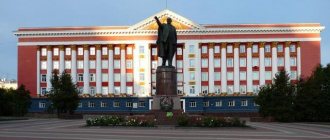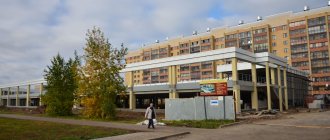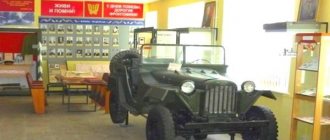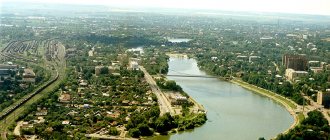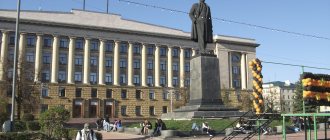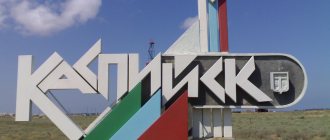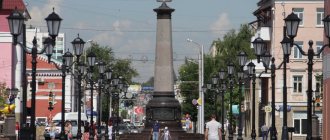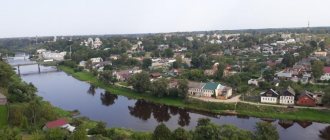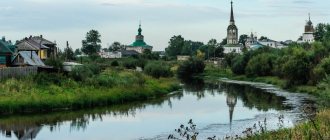Year of foundation: 1626
City Day is celebrated
on August 30
.
In 2021, due to the pandemic, mass events in honor of the city day are canceled or may be postponed
Naberezhnye Chelny, central street
Naberezhnye Chelny
is a Russian city located in the northeastern part of Tatarstan, on the left bank of the Kama River.
The city (called Yar Chally) was founded in 1172 as a military fortress, which ensured the safety of navigation along the Kama. The city was also marked on the map of the Catalan Atlas of 1375. In the 14th century it became the center of the Yar region of the Bulgarian kingdom. In 1557 the city was destroyed by Russian troops. A small village appears on the site of the city.
The settlement has been mentioned in Russian chronicles since 1626
.
The village was called Chalninsky Pochinok, later Beregovye, Berezhnye, Naberezhnye Chelny. In the 19th century, the city became the center of grain trade on the Lower Kama. Temple of Cosmas and Damian In the period 1912-1917, an elevator with a capacity of 2 million poods, one of the largest in Russia at that time, was built in Chelny. In 1930, Naberezhnye Chelny received city status.
During the Great Patriotic War, military hospitals and orphanages were evacuated to the city.
In the post-war period, industrial enterprises were built. On December 13, 1969, construction of the auto giant KamAZ began. In 1983, the city was renamed the city of Brezhnev. In 1987, its historical name was returned to it.
Attractions
The city is represented by religious monuments: the Holy Ascension Cathedral, the Temple of St. Tikhon, Patriarch of Moscow, the Temple of St. Seraphim of Sarov, the Great Cathedral Mosque "Tauba", the Temple of Cosmas and Damian.
The city has a population of more than 533.8 thousand people (2020).
Day of the city
in Naberezhnye Chelny they celebrate August 30, together with another significant holiday - the Day of the Republic of Tatarstan.
NABEREZHNYE CHELNY
NABEREZHNYE CHELNY, a city in Russia, in the north-east. parts of Tatarstan, the center of the city district of the same name and the Tukaevsky municipal district. Us. 532.1 thousand people (as of 1.1.2021); the second largest city in Tatarstan after Kazan. N. Ch. is one of the centers of the urban agglomeration (over 1 million inhabitants), which also includes the cities of Elabuga, Nizhnekamsk and others. The port is on the left bank of the Nizhnekamsk reservoir (on the Kama River). Railroad station. Road junction. Begishevo International Airport (southwest of the city).
Story
Naberezhnye Chelny. Panorama of the city.
In 1626, a group of Elabuga peasants led by F. Popov founded the settlement of Chalninsky Pochinok (from the late 1640s, the village of Mys-Chelny, later Mysovye Chelny, from the 1920s, Krasnye Chelny). From 1630–40s existed s. Embankment Sloboda (Berezhnye Chelny, from the 1910s N. Ch.). In 1650, the Chelny fortress was built to protect them from nomads (dismantled in 1652). All R. 17th century fairs were held in Mysovye Chelny and Naberezhnaya Sloboda. In the 2nd half. 17 – 1st half. 18th centuries villages were repeatedly ruined during the Bashkir-Tatar uprisings; During the Pugachev uprising of 1773–75, their residents were mobilized into the rebel troops and supplied them with food. In the beginning. 19th century at the village Berezhnye Chelny, the Chelny wharf arose (it specialized mainly in grain transshipment, from the early 1840s one of the largest in the lower reaches of the Kama), used to ship through it. including cargo from fairs held in Menzelinsk; offices of large shipping companies operated. In 1912–17, an elevator (the third in terms of storage volume after Novorossiysk and Samara) and an industrial facility were built here. enterprises. In 1921–26, from 1930 the city of N. Ch. (in 1926–1930 the village of Chelny). Center of the Naberezhnye-Chelninsky (Chelninsky) canton (1921–1930), Chelny district (since 1930, renamed Tukaevsky in 1976) of the Tatar Autonomous Soviet Socialist Republic, Tatar SSR (1990–92), Republic of Tatarstan (since 1992). In the 1930s the village became part of N.Ch. Red Chelny. Development of the city in the 2nd half. 20th century associated with the development of oil fields in the southeast of Tatarstan, the construction of the Nizhnekamsk hydroelectric power station and the Kama complex of factories for the production of heavy-duty vehicles (KAMAZ). In 1982–88 the city was called Brezhnev (in honor of L.I. Brezhnev). In 1984, the villages of Orlovka, Sidorovka and others were included in the city; in 2006 – p. Borovetskoye (all known from the 1630s–40s). Since 2005, the center of the city district of the same name and the Tukaevsky municipal district. In 2021 it received the status of a territory of rapid socio-economic development.
Archeology
On the territory of the city, settlements and burial grounds of the Srubnaya culture (Naberezhnye Chelny, Betkinsky, etc.) and the Prikazansky culture (Krasnoklyuchinsky, Kzyltauskoye), settlements of the Imenkovsky culture (Naberezhnye Chelny, Chabyinskoye), and the remains of the Bulgar and Bulgaro-tats were studied. settlements of the 13th–16th centuries. (Orlovskoe, Samoskakovskoe, etc.).
Architecture
Naberezhnye Chelny. Matrimonial Palace. 2007–08. Architects E. N. Pestov, S. G. Popov.
Preserved: c. Saints Cosmas and Damian (1845–59) and the Holy Ascension Cathedral (1872–89) in the Russian-Byzantine style, merchant. houses and shops on the street. Central (late 19th – early 20th centuries), former. the dacha of the merchant D.I. Stakheev on the shore of the Nizhnekamsk reservoir (1908–09; since 1927 the Tarlovsky sanatorium), the Chelny elevator (1914–17). In the 1970s–80s. the city was built up according to the 1973 general plan (architect B. R. Rubanenko and others) with a rectangular layout of “complexes” and wide, extended avenues. The following buildings were erected: 9- and 12-story buildings, lined with shuttle tiles; KamAZ stadium (1975–1977), Transagency building (1977, architect G. Burkov), 14-story Tatarstan hotel (1977–78, architects M. Kh. Agishev, R. Kh. Nasyrov, M. G. Khairullin). In 1982–91, Enthusiasts Boulevard was decorated with monumental compositions (the sculpture “Guardian Angel” by I. M. Khanov, 1991). In the 1990–2000s. built: 24-storey City Center Hotel (1980s – 2008), Ice Sports Palace (2005), Wedding Palace (2007–08, architectural workshop of E. N. Pestov and S. G. Popov) ; mosques (including the Great Cathedral “Taube”, 1989–92, architect M. Basyrov; “Abuzar”, 1993, architects V. A. Manukyan, T. G. Ulatova; “Ikhlas”, 1993–2005, architect Manukyan) and churches (St. Seraphim of Sarov, 1996–2005; wooden Old Believer church of the Prophet Elijah; wooden church of the Nativity of Christ, 2009). Monument of Glory (1975, sculptor Khanov, architect Nasyrov). To the north on the outskirts of the city is the Borovets Keys natural monument with a landscaped pond ensemble. Near N. Ch. preserved: classic. Church in honor of the Vladimir Icon of the Mother of God (1814) in the village. Betki, Trinity Church (1835–52) in the village. Novotroitskoe.
Centers of science and culture
Naberezhnye Chelny State Pedagogical University (1990), a number of non-state universities, branches of universities in Kazan, Moscow and Nizhny Novgorod. Center. mountains b-ka (1972; 29 branches). State Museum of the History of the City (1972), Museums of the History and Military Glory of the Automobile Troops (1986), Ecology and Nature Conservation (2000). Art Gallery (1980; branch of the State Museum of Fine Arts of the Republic of Tatarstan). Russian dramatist. theater "Masters" (1975), puppet theater (1987), Tat. dramatic theater (1990). Concert halls: them. S. Sadykova (1988), Organ (2005; an organ from the Czech company “Riger Closs” is installed in the hall). Chamber orchestra "Province" (1989). Festivals: international puppet theater “Workhorse” (since 2008, once every 2 years), regional theater “Characters” (since 2005, annually), “Organ Assemblies” (2010).
Sport
Among sports competitions, the most popular is football (the KAMAZ team was founded in 1981; a participant in the Russian championships in the top division 1993–97; in the 2020/21 season it plays in the championship of the Professional Football League at the stadium of the same name, built in 1977, reconstructed in 2021 and accommodating 6.2 thousand spectators) and rally [crews of the KAMAZ-Master team, 1988 – 17-time winners of the prestigious Dakar rally (formerly Paris-Dakar) in 1996–2020]. The largest sports facilities in N. Ch. are the Stroitel stadium (1979; more than 9 thousand seats) and the Ice Sports Palace (2004; 1.5 thousand seats).
Farm
N. Ch. is one of the leading industrial centers of Tatarstan. The largest enterprise - the group (1969; leader in the production of heavy trucks in the Russian Federation) produces trucks, trailers, buses, electric buses, special vehicles, engines, and power units. Operating (2010; large-scale assembly of Mercedes-Benz and Fuso trucks).
Production of metal pipes and piles (Naberezhnye Chelny Pipe, 2007), lifting equipment (Naberezhnye Chelny Crane Plant, 1997), electrical installation products, power line supports (electrical installation products plant - branch "Tatelektromontazh", 1977), electrical equipment for dump trucks, excavators, electric vehicles (" Transport Electrical Equipment Plant", 1976), filters and filter elements for cars, agricultural and construction equipment, etc. (1990), plastic products (Technotron company, including plastic spare parts for KAMAZ), corrugated packaging, toilet paper (“National Enterprise Naberezhnye Chelny Cardboard and Paper Mill named after S.P. Titov”).
The following factories operate: large-panel house construction, reinforced concrete structures, cellular concrete, sand-lime brick.
Among the large food industry enterprises are a bakery plant (a large producer of flour, cereals and animal feed in Tatarstan), the Chelny-Khleb group of companies (bakery and confectionery products), meat and dairy plants, companies producing poultry products (Chelny-Khleb Broiler"), ice cream, semi-finished products and fish products ("Cold"), the Bulgarpivo brewery (established in 1981 as the Naberezhnye Chelny Beer and Soft Drinks Plant, its current name since 1994).
Nizhnekamsk hydroelectric power station (1979; 1205 MW), thermal power plant (1971; 1180 MW). In the industrial zone of the city there is the Orlovskoye oil field.
National composition of Naberezhnye Chelny
A city with such an interesting territorial scope does not disappoint in terms of its original mix of nations. According to official data obtained during the population census, almost half of the residents (47.4%) are Tatars, slightly less Russians (44.8%), slightly more than a percentage of the total are Chuvash, Ukrainians and Bashkirs (1.95% , 1.31% and 1.16% respectively). The last places in the population are occupied by the Mari (0.66%), Udmurts (0.39%) and Mordovians (0.39%). The remaining 1.82% comes from other nations, represented by single families or migrants. In total, the required 100% can be equated to the figure - 513,735 people with citizenship. This is approximately 13.6% of the total number of residents of the Republic of Tatarstan. But the volume of industrial production of the total is 14.6%. The city can safely be called young and developing, since the average age of a resident is 36.7 years, and according to the census, the majority of citizens are under 29 years old. Many people have a secondary education, but not everyone goes to study at universities, which is explained by the high need for blue-collar skills.
Mtsensk
A small town made famous by Nikolai Leskov, who wrote the work “Lady Macbeth of Mtsensk”. There are also many variants of names here - Mtsensk, Mtsensk, Mtsensk residents? But they are all wrong. The name is not at all consonant with the name of the city - Amchane.
It turns out that the settlement was previously called Amchansk, which is where the Amchansk people came from.
Construction and its aspects
In Naberezhnye Chelny, residential neighborhoods are designated as complexes and have double addressing, that is, each house has a registration number in the passport and a building address. This tradition dates back to the times when each microdistrict was served by a separate construction team. By the way, street names are rarely explained, so sometimes residents get confused about addresses. In the Komsomolsky and Tsentralny districts there are complexes with the same numbers, which can cause postal collisions. To avoid such situations, it is recommended to use a street address or indicate a city area. Even among local residents there are no shortage of people who want to improve their living conditions and move to new buildings, while city guests are even considering buying only new houses.
Apartments in residential complexes are more cozy and comfortable, transport interchanges are thought out in advance. Little by little, the territory of the New City is being designed and built, on the border of which there is the “Winged” residential complex, designed for 25 floors, offering an excellent view from the window of the city and the Kama River. Highly qualified craftsmen participated in the construction of this residential complex, environmentally friendly materials were used, and brick and panel construction were combined. This residential complex is noted separately due to the use of colored ceramic bricks in construction and the corresponding original exterior. “Winged” is a kind of symbol of the peaceful coexistence of generations, that is, it is not for nothing that it is located at the junction of parts of the city. Apartments here are very expensive, but convenient and comfortable. Potential buyers are also offered the opportunity to purchase commercial real estate in the residential complex; You don’t have to worry about traffic, because shops, shopping centers and educational institutions are located within walking distance.
Transport interchanges
Naberezhnye Chelny is located in the center of railways and highways, so it is always possible to get to the right point in a timely manner. The city has a branch of the Kuibyshev Railway and a Kama branch, which is in charge of transportation in the Kama region.
The city itself is served by two stations: the Round Field, which includes 28 tracks for train communication, a freight yard and a hump; and the cargo and passenger station Naberezhnye Chelny, where loading and unloading of cars takes place, as well as passengers boarding buses. Long-distance trains depart from this station to Moscow, Kazan, Izhevsk, Adler and other cities.
There is also a river port in the city that accepts dry cargo and passenger ships for processing. There is an equipped berth for processing cargo and containers. There is a river station for passengers, designed to accommodate four vessels at a time. Thus, the station can accommodate up to 200 thousand passengers.
What about air travel? And here the picture is very favorable, because there is an international airport “Begishevo”, serving the entire Nizhnekamsk agglomeration.
And for those who do not tolerate flying well or do not want to use the services of the railway, cars are always available; there are plenty of roads in the city; There is a bus station with suburban and intercity bus routes. The federal highway passes through Moscow, Nizhny Novgorod, Kazan and Ufa. In addition, it has access to the cities of Izhevsk and Perm. You can get around the city by tram (14 routes), bus (21 routes) or taxi. By the way, there is a social taxi, designed for a special class of citizens and characterized by great transportation convenience. Trams in the city are close to high-speed ones and facilitate rapid communication between residential areas.
Notable residents
Many wonderful people were born in Naberezhnye Chelny, who are remembered and appreciated mainly in specific circles. For example, Gabdulkhai Akhatov, the initiator of the opening of a pedagogical university in the city, Evgeny Varlamov, a former master of sports and an excellent football player, Firdaus Kabirov, a master of sports in auto racing and winner of the Dakar rally. They speak warmly of Vladimir Vasiliev, an opera singer and director of the Philharmonic. Tamara Tansykkuzhina, world champion in checkers, and Olga Shelest, VJ and journalist, come from Naberezhnye Chelny. There are also many WWII veterans here, in whose honor memorial plaques have been erected.
Culture
If we consider Naberezhnye Chelny as a place of residence, then it is worth paying attention to the issue of education and cultural richness of the area. There are 47 universities in the city, so potential applicants and their parents always have a choice. Technologists will no doubt be interested in the Kama Academy of Engineering and Economics, the Naberezhnye Chelny Institute of Trade and the Institute of Advanced Technologies and Business; managers will like the corresponding Institute of Management or the Kama Academy, and creative people are always held in high esteem at KIID (Kama Institute of Arts and Design) and NISPTR (Naberezhnye Chelny Institute of Social-Pedagogical Technologies and Resources).
Local youth may be interested in enrolling in branches of other universities, such as KAI from the Kazan Technical University, NGLU from the Linguistic University of Nizhny Novgorod, MGSGI from the capital's Humanitarian University and many others. The State Drama Theater with the Batyr entertainment complex and the Illuzium cinema are responsible for cultural life. In addition, there is a puppet theater, fashion and Russian drama. The doors of the Klyuch theater-studio, as well as the city art school, are open to young people. There are several cinemas in the city and all of them are original: in addition to the good old Illuzium, there is the Cinema Park animation complex and a real drive-in cinema, Favorit. The history of the city and region can be clearly studied in the state museum, from where you can head to the museum of military glory, ecology and memory of Vysotsky. Next you will go through the art gallery, the Kamaz cultural center and the organ hall. Since the population is heterogeneous, for many the true cultural values will be religious places, namely mosques.
Administrative division
Conventionally, the city’s territory can be divided into three large districts: Komsomolsky, Central and Avtozavodskoy. Each of them has its own executive bodies. The Komsomolsky district includes the villages of HPP, ZYAB, Sidorovka, Surovka, Orlovka, and Elevatornaya Gora. In addition, the Zamelekesye microdistrict, BSI and Energoraion are adjacent to this area. The central area covers the main industrial and municipal facilities southwest of Highway No. 2, as well as a medical campus and about 36 complexes. Avtozavodskoy district seems to be the most suitable for family living, as it includes areas of low-rise residential buildings, industrial facilities north of highway No. 2, Togaevsky quarry and approximately 26 complexes. In Avtozavodskoye, the construction of new houses is much more active than in other areas, but the time between commissioning is sometimes delayed. Sales here, by the way, are also the most active, since the environment for purchasing housing is the most favorable, there are many green spaces and developed infrastructure, but the level of air pollution is not so high.
Religion and architectural monuments
Almost half of the population professes Islam and regularly visits the Tauba Mosque, which has become one of the new symbols of the city. It is not the only one of its kind, there is also the Abuzar Mosque, Ak Mosque, Bilal, Ramadan and others. In the center of the city is the Nur-ikhlas mosque; The construction of the largest and highest cathedral mosque, Jamig, is completed. In turn, the other half of citizens go to Orthodox churches, of which there are also many. This is the Holy Ascension Cathedral, the temple of the unmercenary saints Cosmas and Damian, the temple of St. Tikhon and St. Seraphim.
There are also Protestant communities in the city, for example, the Church of Evangelical Christians “Revival”, “Good News” and the Seventh-day Adventist Church.
Having satisfied the need for holiness, tourists go for cultural enrichment to monuments, for example, fans of Vladimir Vysotsky regularly visit his square, where a guitar is installed in memory. Contemporary art in the city is embodied in the figures of flying women, internationalist warriors and angels. Local residents proudly show tourists the city’s main 24-story hotel, which is nicknamed the “skullcap” for its unique coloring in the colors of the national flag, and the ledge on the roof. Naberezhnye Chelny also has the main attraction for all children - the only permanent dolphinarium in the Volga region, which is a branch of Anapa. The pool is filled with seawater and is inhabited by six dolphins and one northern sea lion.
Business center of the city
The smooth transformation of Naberezhnye Chelny into a big city involves a number of changes in the course of life and human preferences. Developers keep this principle in mind and strive to satisfy the needs of customers as much as possible. Only wealthy people can afford housing on Mira Avenue, but there is something to pay for here. But when looking for commercial real estate, there is no better place than complexes in the center. In the Central region there is a huge traffic volume of up to 700 people per hour. And at least four thousand cars pass per hour. A good place for the construction of the CityLine TDK. In the future, the area will embody the entire business elite of the city. The complex was built with the latest technology and equipped with utilities. The space is very ergonomic, and only high-quality materials are used in decoration. There are already more than a hundred tenants in the CityLine TDK, but this is not the limit, because the point brings substantial profits to furniture and computer stores, banks, accounting offices and shops.
